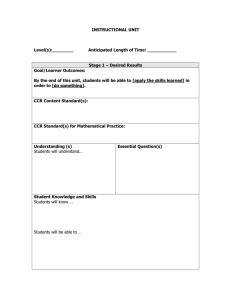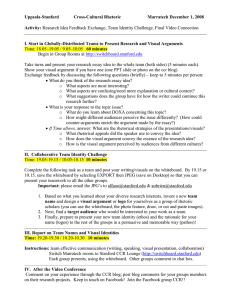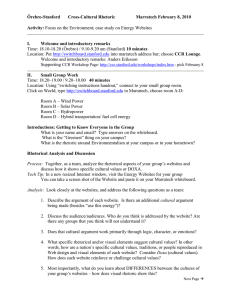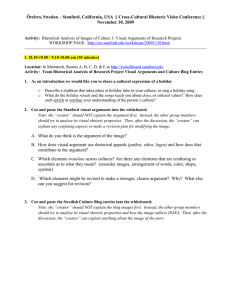2010.02.16.Lesson.OrebroStanford
advertisement
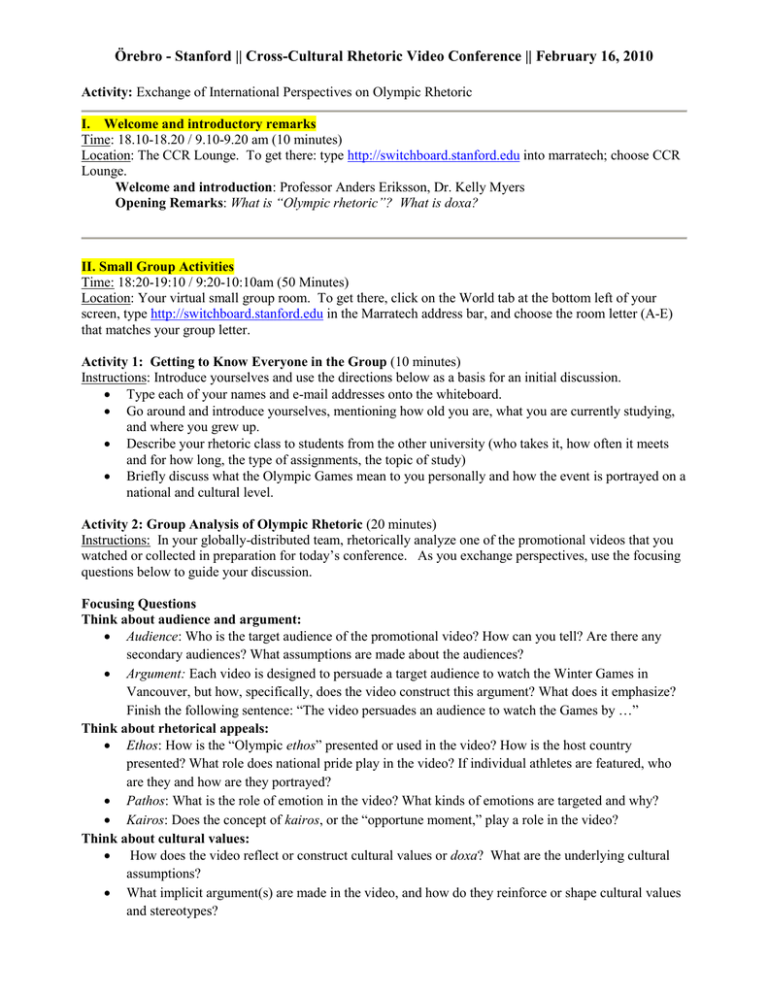
Örebro - Stanford || Cross-Cultural Rhetoric Video Conference || February 16, 2010 Activity: Exchange of International Perspectives on Olympic Rhetoric I. Welcome and introductory remarks Time: 18.10-18.20 / 9.10-9.20 am (10 minutes) Location: The CCR Lounge. To get there: type http://switchboard.stanford.edu into marratech; choose CCR Lounge. Welcome and introduction: Professor Anders Eriksson, Dr. Kelly Myers Opening Remarks: What is “Olympic rhetoric”? What is doxa? II. Small Group Activities Time: 18:20-19:10 / 9:20-10:10am (50 Minutes) Location: Your virtual small group room. To get there, click on the World tab at the bottom left of your screen, type http://switchboard.stanford.edu in the Marratech address bar, and choose the room letter (A-E) that matches your group letter. Activity 1: Getting to Know Everyone in the Group (10 minutes) Instructions: Introduce yourselves and use the directions below as a basis for an initial discussion. Type each of your names and e-mail addresses onto the whiteboard. Go around and introduce yourselves, mentioning how old you are, what you are currently studying, and where you grew up. Describe your rhetoric class to students from the other university (who takes it, how often it meets and for how long, the type of assignments, the topic of study) Briefly discuss what the Olympic Games mean to you personally and how the event is portrayed on a national and cultural level. Activity 2: Group Analysis of Olympic Rhetoric (20 minutes) Instructions: In your globally-distributed team, rhetorically analyze one of the promotional videos that you watched or collected in preparation for today’s conference. As you exchange perspectives, use the focusing questions below to guide your discussion. Focusing Questions Think about audience and argument: Audience: Who is the target audience of the promotional video? How can you tell? Are there any secondary audiences? What assumptions are made about the audiences? Argument: Each video is designed to persuade a target audience to watch the Winter Games in Vancouver, but how, specifically, does the video construct this argument? What does it emphasize? Finish the following sentence: “The video persuades an audience to watch the Games by …” Think about rhetorical appeals: Ethos: How is the “Olympic ethos” presented or used in the video? How is the host country presented? What role does national pride play in the video? If individual athletes are featured, who are they and how are they portrayed? Pathos: What is the role of emotion in the video? What kinds of emotions are targeted and why? Kairos: Does the concept of kairos, or the “opportune moment,” play a role in the video? Think about cultural values: How does the video reflect or construct cultural values or doxa? What are the underlying cultural assumptions? What implicit argument(s) are made in the video, and how do they reinforce or shape cultural values and stereotypes? Activity 3: Collaborative Creation of an Advertisement or Promotional Video (20 minutes) Instructions: Having analyzed several promotions for the upcoming Olympic Games, work together to sketch out a plan for your own print advertisement or promotional video. Begin by thinking carefully about your audience. Do you want to target a specific culture or aim to persuade a universal audience? Then, brainstorm ideas for an advertisement that would persuade your specific audience to watch the Games. Consider the following elements: What assumptions will you make about your audience? What values will you draw upon? What kinds of images will you use? What colors will appeal to your audience? What music? What people will you feature? What setting or scenery will you use? Be specific in your planning and use the collaborative whiteboard to record your ideas. You will be showing this whiteboard to the rest of the groups during final presentations, so be prepared to explain your persuasive strategies (here you may return to the question: “The video or advertisement persuades an audience to watch the Games by…”). In addition, please include at least some of the following details: 1. 2. 3. 4. 5. The theme (and perhaps slogan) of your advertisement The target audience The goal of your advertisement The rhetorical appeals you will use to persuade your audience Supplementary materials, such as images and music, to help us envision your advertisement Pick one person who will be the spokesperson for your group during the presentations at the end of the video conference. Be sure to “export” your whiteboard as a jpg to your desktop when you are done. IV. Report on Collaboration Time: 19.15-19.45 / 10:15-10:45 (30 minutes) Location: The CCR Lounge. To get there, click on the World icon at the bottom left, type http://switchboard.stanford.edu in the Marratech address bar, and choose the “CCR Lounge” link. Instructions: Each group will have 3 minutes to describe their idea to the rest of the Stanford and Orebro students using the whiteboard as multimedia support. We will move in order from Group A to E. V. After the Video Conference: Reflection Time: Due before Thursday, February 18. Location: The CCR Blog (http://ccr.stanford.edu/ccrblog/) Activity: Reflection. Write a 100 word comment to the post about our video conference at http://www.stanford.edu/group/ccr/ccrblog/2010/02/promoting_the_olympics_a_cross.html. Address at least some of the following questions: What were your group’s observations about the specific videos that you looked at? What was most memorable about the video conference? What did you learn about rhetoric and communication across cultures? How did this experience enhance your understanding of the Olympics? Keep in touch with each other on Facebook – join the Cross Cultural Rhetoric Facebook group (see the blog post above for a direct link to our CCR Facebook group) ** Thank you for your active participation! We hope you enjoyed this opportunity for speaking and writing with real audiences across the globe.** -- Anders, Kelly, and the whole CCR team
